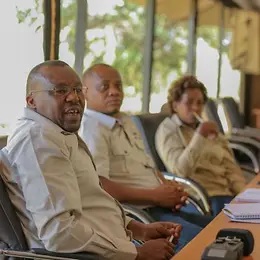Dickson Kaelo, CEO of Kenya Wildlife Conservancies Association (KWCA), discusses Kenya's community conservancy model and KWCA’s integral role in driving the movement forward.

“What motivates me every day is witnessing the progress that is a direct result of conservancies becoming a pivotal part of Kenya’s history,” pronounces Dickson Kaelo, founding CEO of Kenya Wildlife Conservancies Association (KWCA). His passion for the community conservancy movement, which has become firmly established in Kenya over the past three decades, is palpable. In community conservancies land is managed sustainably to integrate wildlife conservation, tourism, livestock, rangeland management and community development. In the Maasai Mara conservancies, where Kaelo is originally from, communities lease out their land for tourism and receive a monthly income from land leases and conservation fees. Through the income from the land leases, ecotourism and livestock management opportunities, the model addresses the interlinked challenges of ecosystem deterioration, wildlife and biodiversity loss, climate change and poverty. KWCA is the national representative body for conservancies in Kenya. KWCA equips its members – landscape-level conservancy associations and conservancies – with capacity building tools and technical support and convenes conservancy members to share information and advocate for favorable national laws and policies to enable conservancies to thrive.
KWCA was founded in 2013 to coordinate the national conservancy network and enable it to spread across the country. Kaelo, an expert in livestock production and wildlife management, was intimately linked to pastoral-wildlife systems from the moment of his birth in the Lemek-Koiyaki group ranch in the Mara. He received an undergraduate degree in livestock and wildlife management and proceeded to work with the government as an animal production extension officer responsible for providing technical advice to farmers on managing livestock production, farming and livestock diseases. He later joined the International Livestock Research Institute as a researcher and community facilitator. Kaelo has served as manager of various wildlife trusts and facilitated the establishment of numerous conservancies. “Because so much of my life has revolved around livestock and wildlife management, I am committed to conservancies being an integral driver of Kenya’s evolution. The only way for our country’s biodiversity and wildlife to survive in the long-term is through community-based conservation.”
The conservancy movement in Kenya originated in the 1970s, as the country’s biodiversity hotspots came under increasing threat from climate change and anthropogenic sources. “In Kenya and most of Africa, people and wildlife coexisted more or less harmoniously for centuries. Through colonialism, the symbiosis between communities and wildlife was compromised.” Today, local communities that live in areas richest in biodiversity are among the country’s poorest, with minimal access to social services, education or security. Poverty is the main driver behind human-wildlife conflicts, poaching and illegal logging, which undermines the ability of Kenya’s unique ecosystem to flourish and exacerbates climate change. Simultaneously, changing weather patterns, droughts and flooding pose an increasing threat to wildlife and forests, compounding a vicious cycle of biodiversity loss, climate change and poverty.
Community conservancies take a comprehensive approach to ecosystem protection, by not only conserving the flora and fauna and reducing the effects of climate change, but also improving local communities’ livelihoods. In the 1990s, only four community conservancies existed across the country; by 2016 there were 167; today the total has increased to more than 200, which amounts to nearly 18% of the country’s landmass. “The conservancy network has led to a change in mindset among the communities, who are realizing the need to continue to coexist with wildlife,” explains Kaelo. With the additional sources of income through conservancies, communities have been able to improve schools, health centers, the water supply and even local infrastructure. Poaching levels have decreased significantly, and populations of wild species are growing.
KWCA has also played a pivotal role in advocating for conservancies’ recognition in policies and laws notably in the National Wildlife Policy 2020, Wildlife Conservation and Management Act of 2013, National Wildlife Conservation and Management Strategy and the Community Land Act 2016. The Wildlife Policy and the Wildlife Act recognize the vital contributions of conservancies, strengthen land rights and allow communities and landowners to prioritize conservation as a land use. “By virtue of the legal recognition under the Wildlife Act, the conservancies were, for the first time, formally established as a strategy to maintain Kenya’s wildlife and to diversify tourism. It was a landmark moment for Kenya.”
LGT VP has been active in the Maasai Mara since 2016 and has worked with conservancies, landscape conservancy associations and tourism operators. KWCA is a key puzzle piece in the Maasai Mara’s conservancy work and fits well into LGT VP’s strategy of supporting community-based, complementary, scalable solutions. “Beyond the financial support, LGT VP has helped us identify gaps we have as an organization and how we can be successful in the long-term.” Kaelo emphasizes the value of LGT VP’s flexible funding approach: “The non-programmatic funding that LGT VP provided allowed us to respond to various organizational challenges rather than be forced to allocate the funding to a specific area or program. Other funders usually provide restricted funding. LGT VP’s support was just we needed at that time.”
Kenya’s conservancy model is growing and promising. In 2016, the conservancy network comprised 11% of the country’s landmass and will soon increase to 18%. While Kenya’s government is targeting the United Nations’ Convention on Biodiversity goal of protecting 30% of the planet’s landmass by 2030, the number for Kenya alone should eventually reach 40%, considering the country’s landscapes and wildlife density. Kaelo has a clear vision for the future of conservancies as well as the role KWCA will play in realizing that vision: “We will have reached success, if every conservancy has multiple income streams, livestock is managed in a way that optimizes natural resources and income is distributed equitably among all conservancy members, including women. KWCA is diligently working to achieve that goal by liaising with government and facilitating and distributing knowledge.”